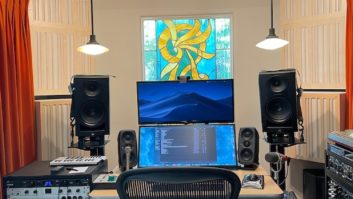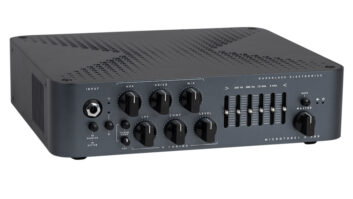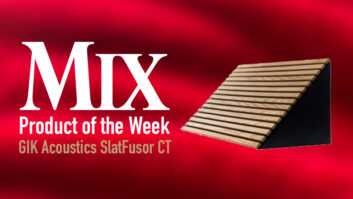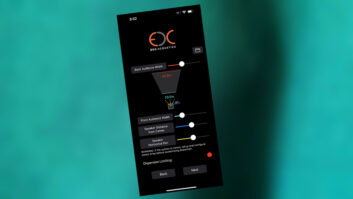Introduced last winter, AKG’s newest Emotion performance microphone is the C 900 condenser vocal mic. It closely resembles the handheld dynamic mics in the Emotion Series, and shares the same tapered body and matte finish, the latter a feature that helps keep the mic in the performer’s grip. In fact, the C 900 looks similar enough to the Emotion D 880 dynamic that AKG has added a thin gold ring below the windscreen to distinguish it. As with most electret condensers, it runs on a range of phantom power from 9 to 52 volts.
The first thing I do with any new vocal mic is unscrew the windscreen to inspect the capsule. The C 900 comes with the PB 1000 presence adapter installed over the end of the capsule, resulting in about an octave of 4dB presence boost centered around 7 kHz. Without it, the C 900 is relatively dull, and, while AKG calls the PB 1000 an accessory, I can think of many applications where this added response would help. Be aware, however, that repeatedly removing and replacing the PB 1000 makes it all too easy to misplace this dime-sized plastic device. The PB 1000 was originally added to the C 1000 when that mic was redesigned a few years ago, and it seems reasonable to guess that the C 900’s capsule is derived from the C 1000’s. My suggestion for users of both mics is to leave the PB 1000 installed and forget about it. And, if you like the C 1000, this is a road version that can double as a great project studio mic.
Users familiar with the C 535 — AKG’s popular live performance condenser for vocals and acoustic instruments for the past two decades — will want to know how the C 900 compares to it. Having spent many years pointing speakers at a certain Canadian chanteuse, I can say that I have an intimate relationship with the 535. On-axis, the 535 is fairly flat, with response tilted slightly toward the highs and with a peak around 7 kHz.
The response of the C 900 is more contoured than the 535. The 900 has a pronounced proximity effect, which broadcast engineers will love. Live sound engineers will quickly learn to roll off the 900 with a highpass filter and possibly also cut some lows. Singers who enjoy the extra power that proximity lends to their voice in the monitors will find the 900 attractive. This mic will stand out in any mix without adding much equalization.
The region from 630 to 800 Hz stands out a few dB, while the rest of the midrange is smooth. A slight dip around 1,500 Hz helps accentuate a gentle peak around 4 kHz. With the presence adapter installed, the boost at 7 kHz is similar to that of the 535, but rolls off more quickly, making the 900 a better choice for loud stages, especially with a drum kit behind the singer. Although there’s less 10 kHz, there’s nearly as much 13 kHz.
At 120° off-axis — the angle most susceptible to feedback when double wedges are used — the 900 exhibits better pattern control and is about 4 dB less sensitive from 1 to 6 kHz than the 535. Monitor engineers know that cardioid mics perform better with a single wedge directly off-axis. At 180°, the 900’s advantage over the 535 is narrowed down to the 2kHz region. I should point out that the 900 costs a third less than the 535.
Comparing the condenser C 900 to a dynamic mic like the Shure SM-58 is not fair, though instructive. The 900 has a bit less “bite” at 1,500 Hz and from 3 to 6 kHz, but provides more “air” around 14 kHz. With the presence adapter installed, there’s also more 7kHz. If you spend a lot of time EQ’ing your favorite dynamic vocal mic, then the C 900 might get you there faster. Monitor engineers will like it because at 120° off-axis, the 900’s rejection is several dB better throughout most of the upper mids, and that advantage extends beyond 4 kHz for sound arriving from directly behind.
Like a few other newer condensers, the 900 has more output than typical vocal mics — as much as 10 dB — so it will seem much louder in comparison, unless the gain is trimmed back. It really stands out from others when used with in-ear monitoring, where its contoured sound provides presence and warmth that make vocals stand out in a mix.
Puzzled by its sound, I wound up A/B’ing the C 900 with a dozen other condensers and dynamics. In my opinion, the 900 is a cat that thinks it’s a dog. Some singers and sound engineers have found that the change from a dynamic to a condenser vocal mic is too drastic. With a list price of $250, the 900 is affordable, competes favorably with higher-end dynamics, and is more likely to convert users of dynamic vocal mics than users of other condensers. Soundwise, it’s midway between what you’d expect from either: A condenser that acts like a dynamic. For those who haven’t made the switch from a dynamic because they haven’t found one they liked or could afford, the C 900 is the vocal mic they’ve been waiting for.
AKG Acoustics, 1449 Donelson Pike, Nashville, TN 37217; 615/360-0499; fax 615/360-0275; www.akg-acoustics.com.
Mark Frink is Mix’s sound reinforcement editor.







